Serial Bear Pennants On The DJIA
There are quite a number of ‘standard’ chart patterns that have been recognised as such since the early years of Technical Analysis -- and there are probably no TA practitioners who do not accept their existence and with near consensus on how the patterns should be interpreted. The channel is the best known of these chart patterns, the Head and Shoulders (H&S) also widely known and used in analysis. The narrowing patterns are the triangle, wedge and pennant and the megaphone is the widening unstable pattern.
The wedge narrowing pattern is generally acknowledged to be a reversal pattern that develops as the extreme at the end of a long term bull or bear trend. While the pennant is also a wedge shaped pattern – becoming a ’flag’ when its side are parallel – it is not a reversal pattern, like the edge, but a continuation formation. The pennant develops within a strong bull or bear trend – not at the end – with the price resuming the original bull or bear trend after the break from the chart formation – which explains the term ‘continuation pattern’.
All the narrowing formations as a rule complete five legs from side to side before the price breaks out of the chart formation. In a minority of these formations a premature break can occur – either in the direction of leg 4 immediately or later after that leg has completed, or, even more rarely, in the opposite direction at a time before leg 4 could complete. The move after premature breaks tend to be steep and sustained, more so if the break took place while still on leg 4.
Also rare is when the price does not break from the pattern after the five legs have been completed, but continues to complete legs 6 and 7, when the break from the pattern takes place. More than 7 legs is exceedingly rare and then are typically also the uneven number of 9 legs. These extended patterns generally only appear in charts of the precious metals, gold and silver, and in forex. It has been assumed that abnormally long patterns develop because of manipulation of the price by some outside force.
There is much more to the nature of these patterns that fall outside the scope of this essay. The above is sufficient information to discuss and review the series of pennants that developed in the DJIA subsequent to the bear market of 2007/9. Statistics gathered decades ago appear to find that about 85% of all narrowing chart formations complete normally, i.e. they consist of five legs, counted from side to side, with the break taking place at the end of leg 5 or shortly after. The break resumes the original trend before the pattern developed.
First pennant
Chart 1 shows the DJIA from June 2007 to March 2012, with T marking the all time high at that time at 14164 on 9 October 2007. The figures 1 to 5 mark the ends of legs 1 to 5 of the pennant.
The decline from the high at 14164.53 to the low at 6547.05 was followed by the move higher to the end of wave 4 (breaking just above the top of the pennant) at 11204.28. The retracement is equal to 61.14% of the decline, quite close to the Fibonacci ratio of 62.18% that is often used in TA for the top of a correction counter to a major trend. This result supports the contention that the recovery that had started in March 2009 was the normal correction out of the steep bear market that had declined by almost 54% from the high in October 2007.
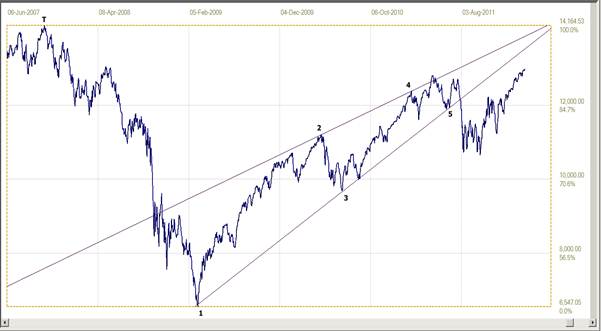
Chart 1. DJIA: June 2007-March 2012
The legs within the pennant fits well to the two sides of the pennant. Both leg 3 and leg 4 completes two consecutive reversals against their respective pennant boundaries before setting off for the opposite boundary, but double bounces off the same boundary is a frequent occurrence. There is only the minor and brief break higher at the final end of leg 4 that does not fit the pennant exactly.
The break lower after leg 5 is steep, until the DJIA enters a volatile sideways consolidation that later begins a steep rally that follows the bottom of the old pennant. The consolidation lasted from 8 August to 3 October of 2011 and, I believe, that covered a period of initial indecisiveness as to what future actions were to be. During this time of consultation, the President’s Working Group on Financial Markets (also known as the PPT – Plunge Protection Team) established by President Reagan in 1989 following the 20% crash in October 1987 – made sure that they acted in terms of their mandate, “ . . . to reduce volatility in the financial markets”, or words to that effect.
I leave it to the reader to consider what the PPT had to do at a time when s very steep plunge in the DJIA was under way, having broken below a major support trend in conformance with more than one well-known technical indicator showing a bear market having resumed and on its way to what could be expected to be a new post March 2009 low. The high volatility until to 3 October shows this was a time of intense bull-bear action on Wall Street, when the new bear market ran into opposition in support of the market.
On 4 October the reversal higher finally started and from there it was a new bull market for equities. This introduces a number of rather strange “coincidences” – and again readers may make of these as they will.
US Treasuries
A rally in the US bond market had started late in July 2011, taking the yield on the US 10-year Treasury Note from 3.03% straight down to a major post 2007/8 low at 1.72% on 22 September. The yield then reversed sharply to have it back at 2.42% on 27 October, 2011. Further very high volatility in the bond market ended with another rally down to 1.43% in July 2012, a final post 2007/8 low. Around that time there was much talk of the Bond Market Vigilantes having gone to sleep; however, after 27 October the trend in the yield was decidedly bearish, almost as if they had woken up.
Or was it that TPTB had realised that a too strong bond market could become a major problem if holders of bonds thought there was a major bubble that could become a crash and it would be better to sell and sit with the profits and they made sure that the market reversed direction. Remember China and some other foreign central banks were heavily invested in US Treasuries and they could be tempted to reduce their exposure as long as they did not rock the market.
The US dollar
A good rally that had started off 73.72 on 29 August 2011 carried the US dollar index to a high at 79.60 on 4 October, after which the dollar plunged lower to be at 74.88 on 27 October. A steep reversal higher the next day started a new bull market in the US dollar that, after an extended and volatile three years saw the recent major bull market taking off in 2014.
Gold
The price of gold in terms of the London PM fix peaked at $1895 on 9 September 2011. Since then gold has been in a major bear market. At first it moved mostly sideways in a broad and very volatile range, until a steep and sudden sell-off in April 2013 entered the final and again volatile phase of the bear market.
It would thus seem that four major US markets were in some turmoil in a period around August-October 2011, after which major new trends developed in all four these markets. It could of course be coincidence, triggered by similar events and trends in different aspects of the US economy. Readers should note there was no formal and public announcement of a new QE program, which may have affected all markets, during this period. This implies that the four major changes in trend in these markets, all of them in one way or another favourable to the attempted recovery in the US economy, happened as natural coincidence. Which, of course, is not impossible to believe.
Second pennant
The second pennant, as shown in Chart 2, was an extension of the in Chart 1. It has been known for a long time in my study of chart patterns using the discipline of Chart Symmetry, when a well defined chart pattern is broken as a result of an event that comes as a shock to the market, the older pattern extends into a new pattern. When this happens without public awareness of any shock that might be the cause, suspicion is that there was some intervention in that market.
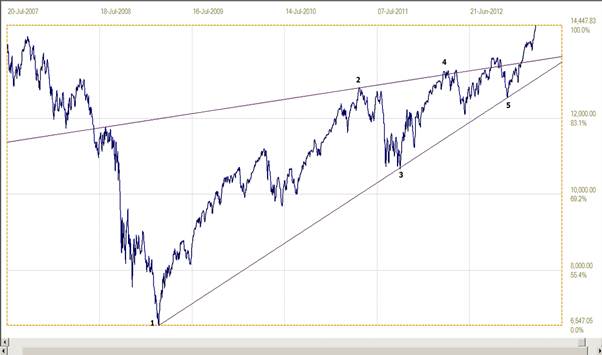
Chart 2. DJIA: July 2007-March 2013
Comparison with Chart 1 shows that the period of volatility following the break at the end of leg 5 of the first pennant, was the end of leg 3 of a larger pennant that carried the DJIA to a high around 13600 that was just short of the previous all time high at 14165. The count of the legs is unambiguous, as before, and leg 4 again has double contact with the pennant boundary, breaking just higher from the pennant on the two occasions.
This time, though, there was no penetration below the pennant at the end of leg 5. The DJIA fell quite steeply after the end of leg 4 to close right on the support trend line passing through previous lows – a feature that would be noticed by just about all technical analysts that follow the DJIA. A break lower at that time, if it had happened, surely would have been a major sell signal for a good portion of the already nervous stock market, attracting wide comment in the media.
The reversal off the support resumed the bull market and in good order the DJIA broke above the pennant at the end of leg 6 – a very rare occurrence – while it held to a steep rising trend.
Third pennant
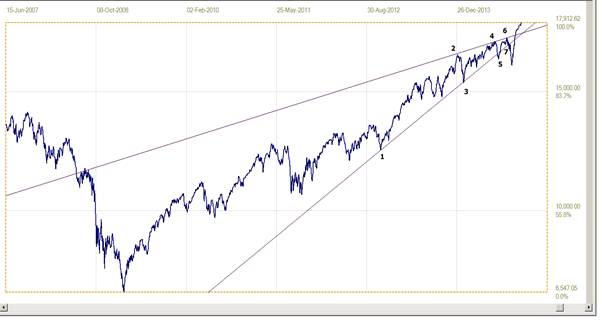
Chart 3. DJIA: June 2007-November 2014
The end of leg 5 in the second pennant is now seen as the end of the extended and wide ranging leg 1 in the third pennant. Leg 2 was also an extended, steeply rising trend, followed by a sudden sell off during January 2014. By then the new pennant had narrowed to the extent that the remaining legs of the pennant were squeezed for time. Leg 4 was a sustained rising leg that reached a new high for the DJIA in July 2014. The sell off that formed leg 5 of this pennant broke a little below the pennant to issues a new sell signal.
As happened at the end of leg 5 in the first pennant, a break below the pattern was a signal for the start of a new bull trend. Within the relatively little time that remained before the two boundaries of the pennant closed against each other an additional two legs were completed by the DJIA. Seven legs in a narrowing has long been interpreted as an indication of intervention in the market that is trying to maintain the ruling trend at the time. Leg 7 was then, as expected, followed by the steep sell off of October 2014, which began off a goodbye kiss on leg 7 after a minor break lower at the start of the month.
As has happened regularly, the sell-off was not permitted to extend further, but reversed as steeply as before in similar circumstances to begin a new rally.
Fourth pennant
While the sell-off at the end of leg 7 in the third pennant broadened the base for the new pennant, it was clear from the accelerating swings in the market time was running out for the bull market – a view that was becoming more prevalent among commentators around the fringes, while the main media were mostly still bullish at that time.
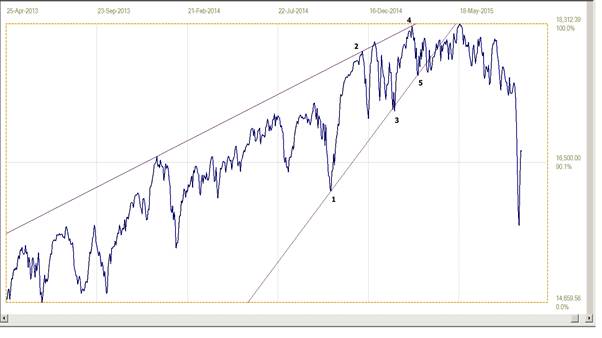
Chart 4. DJIA: April 2013-August 2015
The leg 7 sell off in the previous pennant was the end of a rather volatile, mostly sideways ranging leg 1 of the new pennant. Its leg 2, starting off the low of the new sell-off, however, was a strong bullish impulse trend that yet again reached a new high for the DJIA. From then on there was a marked increase in volatility – a sign that the market was becoming very nervous.
Leg 3, for example, experienced 7 steep, sudden and volatile trend reversals on its way to the bottom of the new and rather blunt fourth pennant. Leg 4, again off a recent low just like leg 2, was steep and sustained, with few and only small corrections, as if the trend was tightly contained after the previous high volatility of leg 3. The bearish leg 5 was again sudden and steep, rebounding into leg 6 off an obvious support trend line – much as what happened in the second pennant.
This time leg 6 could not be completed; the market ran out of steam and broke from the pennant in a sideways quite volatile drift. This resulted in a double top, level with the end of leg 4 of this pennant, and the start of what so far seems to be a major correction.
Composite chart
The composite chart below shows the overlapping four pennants that developed since the end of the post 20078 sell-off in March 2009. The very good fit of the four pennants to the boundary lines of the chart patterns is far too close to deny their presence in the behaviour of the DJIA.
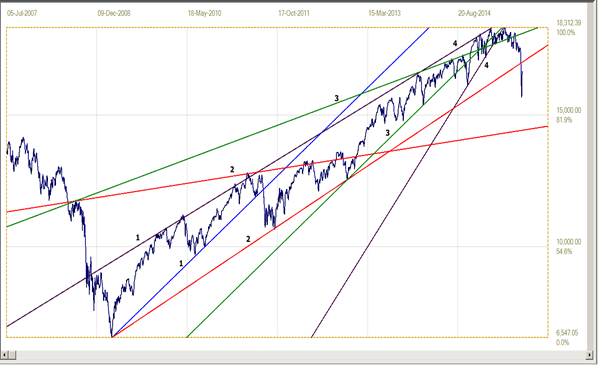
Chart 4. DJIA: July 2007-August 2015
Note that the top boundaries of pennants 1 and 4 are so similar they are here represented by the same trend line. Further, while it is prudent to allow for more and major intervention, it seems the break below the extended lower boundary (red) of the second pennant is the start of a long term bear market. It could be that the top boundary of the second pennant (red) could in time become a level of significant support at around 14450 points, still higher than the tops of the first two pennants and thus not a major correction relative to the pre-crash high in October 2007.
Conclusions
The evidence strongly suggests that from about September-October 2011 there was significant and sustained intervention on Wall Street. This intervention may well have been synchronised with similar action in other US markets. Convincing evidence of such covert operations are most likely unobtainable, but knowledge gained over decades of studying chart patterns, including pennants, has shown that certain gross aspects of these patterns are quite stable over different time scales and different markets.
A double top that was not subsequently challenged is the first widely recognised technical signal that the bull market could be over, with the later steep sell-off as the confirmation of this earlier signal. Early indications from the patterns are that the bear market could be very long and reach very low – as the market may have done if there were no intervention after the end of the first pennant.
(c) 2015 daan joubert All rights reserved
















